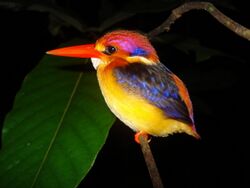Biology:Ceyx (bird)
| Ceyx | |
|---|---|

| |
| Oriental dwarf kingfisher (Ceyx erithaca) | |
| Scientific classification | |
| Domain: | Eukaryota |
| Kingdom: | Animalia |
| Phylum: | Chordata |
| Class: | Aves |
| Order: | Coraciiformes |
| Family: | Alcedinidae |
| Subfamily: | Alcedininae |
| Genus: | Ceyx Lacépède, 1799 |
| Type species | |
| Alcedo tridactyla[1] Pallas, 1769
| |
| Species | |
|
see text | |
Ceyx is an Old World genus of river kingfishers. These kingfishers are found from South East Asia to the Solomon Islands.
The genus was introduced by the French naturalist Bernard Germain de Lacépède in 1799, and derives its name from the Greek myth of Alcyone and Ceyx.[2] The type species is the black-backed dwarf kingfisher (Ceyx erithaca).[3]
A molecular phylogenetic study of the alcedinine kingfishers published in 2007 found that the genera as then defined did not form monophyletic groups.[4] The species were subsequently rearranged into four monophyletic genera. The little kingfisher, azure kingfisher, Bismarck kingfisher, southern silvery kingfisher and Indigo-banded kingfisher were moved from Alcedo to Ceyx.[5] All except one of the birds in the reconstituted genus have three rather than the usual four toes. The exception is the Sulawesi dwarf kingfisher which retains a vestigial fourth toe.[4][6]
The Moluccan dwarf kingfisher (Ceyx lepidus) was previous named the variable dwarf kingfisher and included 15 recognised subspecies. A genetic study published in 2013 found that most of the subspecies had substantially diverged from one another.[7] The species was therefore split and 12 of the subspecies were promoted to species status. At the same time the name was changed from the variable dwarf kingfisher to the Moluccan dwarf kingfisher.[5]
The two African species in the genus Ispidina were sometimes placed in this genus.[8] Compared to the related species in the genus Alcedo they are more terrestrial.[9]
There are 23 species in the genus:[5]
- Black-backed dwarf kingfisher, Ceyx erithaca
- Rufous-backed dwarf kingfisher, Ceyx rufidorsa – split from C. erithaca
- Philippine dwarf kingfisher Ceyx melanurus
- Sulawesi dwarf kingfisher, Ceyx fallax
- Sangihe dwarf kingfisher, Ceyx sangirensis
- Moluccan dwarf kingfisher, Ceyx lepidus – previously named a subspecies of the "variable dwarf kingfisher"
- Dimorphic dwarf kingfisher, Ceyx margarethae – previously a subspecies of the variable dwarf kingfisher
- Sula dwarf kingfisher, Ceyx wallacii – previously a subspecies of the variable dwarf kingfisher
- Buru dwarf kingfisher, Ceyx cajeli – previously a subspecies of the variable dwarf kingfisher
- Papuan dwarf kingfisher, Ceyx solitarius – previously a subspecies of the variable dwarf kingfisher
- Manus dwarf kingfisher, Ceyx dispar – previously a subspecies of the variable dwarf kingfisher
- New Ireland dwarf kingfisher, Ceyx mulcatus – previously a subspecies of the variable dwarf kingfisher
- New Britain dwarf kingfisher, Ceyx sacerdotis – previously a subspecies of the variable dwarf kingfisher
- North Solomons dwarf kingfisher, Ceyx meeki – previously a subspecies of the variable dwarf kingfisher
- New Georgia dwarf kingfisher, Ceyx collectoris – previously a subspecies of the variable dwarf kingfisher
- Guadalcanal dwarf kingfisher, Ceyx nigromaxilla – previously a subspecies of the variable dwarf kingfisher
- Malaita dwarf kingfisher, Ceyx nigromaxilla malaitae – subspecies of Guadalcanal dwarf kingfisher
- Makira dwarf kingfisher, Ceyx gentianus – previously a subspecies of the variable dwarf kingfisher
- Indigo-banded kingfisher, Ceyx cyanopectus – previously in Alcedo
- Southern silvery kingfisher Ceyx argentatus – previously in Alcedo
- Northern silvery kingfisher Ceyx flumenicola – split from C. argentatus
- Azure kingfisher Ceyx azureus – previously in Alcedo
- Bismarck kingfisher Ceyx websteri – previously in Alcedo
- Little kingfisher Ceyx pusillus – previously in Alcedo
References
- ↑ "Alcedinidae". The Trust for Avian Systematics. https://www.aviansystematics.org/4th-edition-checklist?viewfamilies=86.
- ↑ Lacépède, Bernard Germain de (1799). Discours d'ouverture du Cours d'histoire naturelle des animaux vertébrés et a sang rouge: Tableau des sous-classes, divisions, sous-divisions, ordres et genres des oiseaux. Paris: Plassan. p. 10. https://books.google.com/books?id=6uhAAAAAcAAJ&pg=PA84.
- ↑ Peters, James Lee, ed (1945). Check-list of Birds of the World. 5. Cambridge, Massachusetts: Harvard University Press. p. 178. https://www.biodiversitylibrary.org/page/14480189.
- ↑ 4.0 4.1 Moyle, R.G.; Fuchs, J.; Pasquet, E.; Marks, B.D. (2007). "Feeding behavior, toe count, and the phylogenetic relationships among alcedinine kingfishers (Alcedininae)". Journal of Avian Biology 38 (3): 317–326. doi:10.1111/J.2007.0908-8857.03921.x.
- ↑ 5.0 5.1 5.2 Gill, Frank; Donsker, David, eds (December 2023). "Rollers, ground rollers & kingfishers". World Bird List Version 14.1. International Ornithologists' Union. http://www.worldbirdnames.org/bow/rollers/.
- ↑ Fry, Fry & Harris 1992, pp. 8-9.
- ↑ Andersen, M.J.; Oliveros, C.H.; Filardi, C.E.; Moyle, R.G. (2013). "Phylogeography of the Variable Dwarf-Kingfisher Ceyx lepidus (Aves: Alcedinidae) inferred from mitochondrial and nuclear DNA sequences". Auk 130 (1): 118–131. doi:10.1525/auk.2012.12102.
- ↑ Fry, Fry & Harris 1992, pp. 195-198.
- ↑ Woodall, Peter (2001). "Family Alcedinidae (Kingfishers)". in del Hoyo, Josep; Elliott, Andrew; Sargatal, Jordi. Handbook of the Birds of the World. Volume 6, Mousebirds to Hornbills. Barcelona: Lynx Edicions. pp. 103–187. ISBN 978-84-87334-30-6. https://archive.org/details/handbookofbirdso0001unse/page/103.
Sources
- Fry, C. Hilary; Fry, Kathie; Harris, Alan (1992). Kingfishers, Bee-eaters, and Rollers. London: Christopher Helm. ISBN 978-0-7136-8028-7.
Wikidata ☰ Q900889 entry
 |

